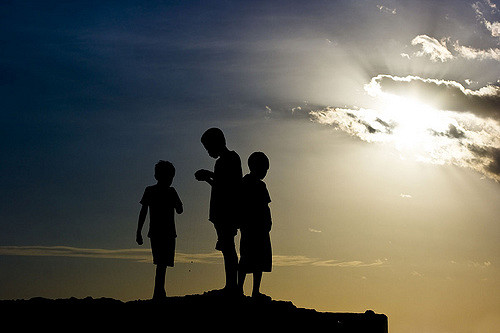
The fact that three separate families—including the children—perpetrated the attacks in Surabaya two weeks ago is obviously horrifying. But Islamic State’s (IS) use of women and children isn’t unprecedented. Governments must be aware of this to develop a better understanding of what the threat looks like if they’re to cultivate and implement robust measures to prevent and counter violent extremism (P/CVE).
Women have been engaging in
political violence for decades, so the idea of women being radicalised towards terrorism shouldn’t be surprising. A 2017 report from the
Heritage Foundation concluded that 17% of terrorist plots in Europe since 2014 featured women. IS also claimed responsibility for an attack perpetrated by
three women at a police station in Mombasa in September 2016, and
authorities in Morocco disrupted a group of 10 women planning suicide attacks across the country a month later.
Children are also vulnerable to being exploited and recruited for violence for tactical benefit. The Heritage Foundation noted that 25% of attacks in Europe since 2014 involved teens or pre-teens. From 2014 to 2016, IS is thought to have
recruited and trained more than 2,000 boys—referred to as the ‘Lion Cubs of the Caliphate’. Between April 2011 and July 2017,
at least 56% of Boko Haram’s 434 bombers were women, and 81 were children or teenagers. Using child soldiers gives groups and their attacks maximum publicity. In addition, training and indoctrinating children from an early age is an investment in the organisation’s longevity.
In 2014, notorious Australian jihadi
Khaled Sharrouf tweeted a photo of his seven-year-old son holding a man’s severed head. The caption read, ‘That’s my boy.’ Sharrouf’s teenage daughter, Zaynab, was one of the most vocal advocates for violence against the West on her social media channels in 2014 and 2015.
One of the key contemporary challenges to national security relates to returnees from the caliphate overseas. It would be helpful to evaluate how P/CVE initiatives are engaging with women and children returnees, and to know where the gaps and challenges lie and how the initiatives could be improved.
At present, best practice in dealing with women and children returnees remains
underdeveloped. Much more research is required to inform training. For now, there are three clear areas where a gendered perspective could be helpful when dealing with female returnees.
First, although
women were recruited to IS to fulfil domestic roles, others were engaged in various forms of violent action. Upon returning from overseas, they’re very likely to have extensive knowledge of bomb making and weapons use. Ensuring that P/CVE assessments are equipped to discern what skill sets each individual has is important in order to appropriately assess the risk of violence each individual may pose upon reintegration into communities.
Second, because current P/CVE policy and practice relies on particular notions of masculinity and femininity, women are perceived within a
‘maternal logic’ that sees them as innately less dangerous than men. Extensive research has shown that
violent extremism appeals to men and women in equal measure, and that women can be as ideologically committed as their male counterparts. However, P/CVE measures fail to integrate these findings when designing and implementing initiatives. This not only denies women agency in their motivations and grievances, but it fails to understand that men and women may pose a similar threat to national security.
Third, women have been avid recruiters for IS, whether encouraging individuals to make a
hijrah to the caliphate, or encouraging them to carry out attacks at home. Due to cultural restrictions in some Muslim communities, making contact in public places isn’t always possible for women and may restrict their physical contact with potential recruits. As a result, women have cultivated strong networks online, taking advantage of the anonymity the internet provides. P/CVE initiatives that aim to ‘engage’ members of the community need to be aware that men and women may not frequent the same places. Those programs may have to extend their reach to connect with individuals online as well as offline.
Children pose a separate set of challenges to P/CVE policy and practice, which aren’t adequately understood either. Any child returning from a conflict zone will require a very specific type of care to address the physical and mental trauma they’re likely to have experienced. Those returning from Iraq or Syria may have been involved in violence or been trained as child soldiers. This is a complex situation where children are at once victims and perpetrators of violence.
Although the chance that a child would continue with political violence can’t be known, it’s crucial that P/CVE initiatives and interventions deliver appropriate support, rehabilitation and reintegration services to deal with the long-term consequences of these children’s trauma. That includes providing education and employment opportunities, mental health support, positive mentors and guardians, and a safe environment to ask questions without being penalised.
The way we currently approach P/CVE policy and practice doesn’t effectively interrogate the ways in which women and children have been affected by violent extremism, or how they could pose security risks. As
Sidney Jones has argued, ‘deradicalisation has to happen as a family’ when dealing with someone who could be at risk of radicalisation, whether that person is a returnees or has never left home.
Not only is it important to apply a gender lens to P/CVE policy and practice, but it’s imperative to develop interventions that minimise risk and build resilience into the long term, rather than as a reaction to the current problem. That’s the most appropriate means of ensuring a positive outcome.
 Print This Post
Print This Post